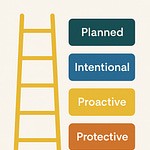“The right tool for the right job makes all the difference.” – Benjamin Franklin
“Tools empower us to do more than we could do alone.” – Barack Obama
“Tools are the extension of man’s knowledge, ability, and potential.”
– Bruce Lee
"Do not wait; the time will never be ‘just right.’ Start where you stand, and work with whatever tools you may have at your command, and better tools will be found as you go along." - George Herbert
"To the man who only has a hammer, everything he encounters begins to look like a nail." -Abraham Maslow
I still remember the day when I stopped writing something in my journal and moved to the computer. It is not so much a day I remember but a feeling like something was happening like a trance, and I didn’t want to be too present. The memory is in the felt sense I had in my body that something was changing, and my emotional pain was turning into something else. There were months where I blocked myself from knowing that what I was doing was writing a book that would integrate me and help me be myself more authentically. It was news to me when Microsoft Word said I hit 83 pages. I shook and I did not take it well. It felt like too much pressure, and I questioned myself. Then I realized I was writing a human story. The Tools I used for seeing things better and reprocessing that into a shakingly new self-concept where inside this book in the making and it was okay to be like a fawn on new legs. I learned through the process that I would have to ask for a lot more help and really put myself out there more than I ever have.
I have to write a book proposal, beg the publishing world to see this as worthy. You will hear on this podcast, or read if you are on the Substack page, my call for help to get this out there but no matter what, I promise to put it all out here to you ENYA Community, I will come to you here somehow ALWAYS and deliver the tools no matter if I am picked or not. Some tools are already posted, the ENYA Podcast on Spotify, we will be delivering them piecemeal with gaps in between to help you pace your process. If you have not listened to the first episode “Do You Want to Listen or Begin”. I hope you can listen to the episodes in order, they may be posted most recent first so please scroll down. At times episodes themselves will be pauses between The Tools to expand and create room for a gentle process. Please access them in order if possible. Listen/Read on.
I am a person who has been searching. I’ve done it haphazardly, lost and alone. I have done it with mistaken ideas and the wrong structure. I did it with love and then with grief in my heart. I have done it as an expert in getting you through things. I have failed at it, and that may just educate me most of all. It certainly has seasoned me most. I am also, in another part of myself that now integrates with all the rest finally, an expert. I am a Mental Health Therapist with 17 years of experience, and I am a Certified Clinical Trauma Professional (Level 2).
So, I have arrived at this “expert” status, first as a person searching and then from completing additional years of training, certifications, and applied practice in the field. All this expertise, I realize now, was done in the ongoing pursuit of something that is bigger than any of those qualifiers. The Tools were the thing I was working on all along. The Tools that show me, as the title reflects, I am NOT BROKEN.
I am a true expert in repressed “Stuff” and have sensed it my whole life in others. Why I sense or how I came to it is not as important to me now as conveying I know I have this sense to help clarify what is happening in all of us. Everyone is born with a purpose. Mine is to show you how to come to the repressed parts of your Narrative with Tools. I have been overwhelmed and shamed by symptoms that hide the intensity of what I held back from myself. As a pre-teen I imagined myself a journalist, then a reporter, because I wanted tools from a young age to be able to tell everyone what was happening with me and with them and for it to all make sense like they do on the news. They thought I was too sensitive. While that was half right; sensing yourself and everyone else and not knowing how to decide what to do with the conflicting information is a sensitivity, but for any brain it is also an overprocessing. I was taxing my brain to figure it all out. When we work in this way in the brain, it assists repression. We figure out the wrong things or conversely start avoiding, find other work to crank out so there is no space for it.
This book, NOT BROKEN, This is Your Stuff, These are The Tools. Therapists are People Too is the end to my figuring and begins the adventure of empowering people to have The Toolbox Approach for their lives. As the quotes depict above, tools are essential, and our thought leaders have always promoted them. These tools are more than conceptual however, they are for reprocessing and somatic awareness and go further than talk therapy can go. Even though there is childhood trauma in my story, now I know the drive was always in me to see the deeper story. For me, the real trauma was feeling it all in everyone and myself before I was developed enough to understand it. I wanted to see myself and only saw the reflection of my smallness in everyone else's eyes, I was a kid. We all have a version of that very basic pain, left out of some self-understanding and therefore invisible in some bigger way. We are all connected in this “holding things” condition. These things, “Your Stuff”, are much deeper than the problems we have or the things we would say are in our way.
I know therapy was developed into this complicated device in which we say the individual cannot see the problem clearly and requires an expert but that tends to deny the underlying and simpler human need for a therapeutic relationship. We need someone there with us because we don’t know how to look inward. The other person, if trust can be established, is that device or mirror. The trouble is that the trust violations that keep us from looking inward are remembered through both conscious and unconscious memories of experiences where trust was missing. The therapeutic relationship will remind us of all relationships where we hoped for trust, and it was not there. Entering therapy is risky because people are untrustworthy even if they are trying their utmost not to be. We feel this risk, all of us.
As a therapist I try to be a “safe space”, but I cannot know the experience of the other person and how I may land on them, or in them, differently because of what they have been through in life. So, while we aim to avoid being overwhelmed by it all when we decide to trust this process, and a therapist, it is still very emotionally risky. In the school setting we have the buffer of our own ability to study, we have the material we know to learn in the book, we have tools for learning despite the relationship with the teacher. Therapy is a good idea but an odd expectation, “Just trust me!”. That is why the Toolbox Approach is so necessary.
The inward journey of learning yourself and what has happened and the meaning you make of this “happened” deserves steadfast and stable tools just as reliable as any tools of any “work” we decide to take on in life. So, that you trust you better to do the job of looking inward. This requires The Toolbox Approach. Helping you enter the stages of seeing your life, reprocessing for deeper awareness and clarity, and then lastly relating as a healing container, can secure a better process for repeatedly growing. As you come out of old, stuck ways in a reprocessing phase, the other phases are there to support you and propel you equally.
The wisdom that lies in both understanding our lives, and not being able to fully understand them, is not something we ever get to possess. This is because wisdom or insight is not static or fixed and it is a process of using tools and being in our lives fully with all the “Stuff”. We hold the tools for this process regardless and there is profound learning and realization in their use. So, this book may most notably be written by your Crash Test Dummy on this collision course called “working on Your Stuff”. We don’t need to crash into our “Stuff” however.
As a therapist, that is often when people seek me out, when they have crashed in some way, because when anyone has their own unique version of a crash in their life, the urgency to look inward is clearer. I know there is a better way. I know because my own REAL STUFF lay hidden for over 35 years. At least two decades of that span of 35 years was spent in pursuit of mastery in the mental health field, and as attested above, the wisdom was not mine to possess. I would never get there and be past everything because we are meant to hold our experiences. There is nothing wrong with holding things, however we are unaware what we are holding and there are things left undigested and blocking us and require The Tools here in NOT BROKEN.
I have over nine specializations and like many in the field, much of my career expertise was fueled by lived experiences I had wanted to help myself through and yet had gotten through imperfectly. A therapist, if they are honest, heals through the work too. It was devastating when I realized that with all my expertise, not at all the “Stuff” I ultimately needed to address in the search to finding a more complete Self was in my awareness to work on. When my mother passed away from pancreatic cancer in 2021, a pandora’s box of repressed trauma revealed to me how desperately my own tools needed to be refined and put to new use on myself. Her death opened up repressed memory. This was a pattern of childhood sexual intrusion, manipulation and molestation that I lacked, at age 5-10 years old, the understanding to know was not a game I wanted a secret pass to.
The trapped shame changed my psychology in ways I needed to look at but I was stuck to “just talk”. The repression was lifting but a wall of defenses boxed me in, making me feel as though it was me against me. It was the me that had faced the world backed against the me that needed to look inward and we were together in a standstill blocking me from seeing the very experiences that had formed my self-concept. I was blocked by the fear of losing my armor, my professional self, and my proof I was NOT BROKEN. What if it was all just a flimsy idea of moving on? The idea that I had found a purpose through moving on and becoming a therapist began to falter. Often the journey does begin with fear of losing yourself. My strategies felt like only thought-based healing, just like drinking more water can be thought of as good for you without a real measure or goal in sight for the healthy water drinking you. Becoming a therapist felt like progress, but was it just like losing weight on a diet? It can seem like it is you and not the rigidity of the diet, but is it?
I knew I had seen this before in others that come to me for therapy, and I was turning to see it in myself. Was being a therapist a mask? I knew then, I could be brave and admit even an expert can get their own moving on wrong. I felt then that to come out with all I have got, lived experience and expertise, is my real purpose. I rose, NOT BROKEN. I developed the Toolbox Approach here. It must be shared because my sessions are not enough. Expert is not enough. Sometimes you must trust yourself profoundly first.
That is what this book is meant to showcase, a blend of two things about the human condition, we do not know how to see ourselves without tools, and we need help learning and mastering these tools. The myth of Narcissus traditionally tells how a youth, whose name was Narcissus, loved his own image so much that he spent days looking at his own reflection in a lake. One day, he was so infatuated with himself that he lost his concentration, slipped and drowned in the lake. A flower grew where he fell, and this plant came to be called the narcissus. As the story of Narcissus and the lake will tell you, looking at yourself alone in the reflection of water is a misuse of the tool of reflection. Furthermore, if you look to grow only flowers out of this reflection, it is a loss; a memorial that is left there on the ground in the symbol of a pretty flower only.
Therapy is a tool that needs the refinement of the individual coming to it informed on themselves. They need to be already on their brave course of inward looking. I AM a therapist and I wasted decades on what I thought was a journey seeking myself. We cannot see ourselves without tools and then the expertise to use them. It is lacking or missing in one’s education or resources no matter who you are, professional or not, because they are not in our systems of education and only hidden amongst other systems that one must find like that of a treasure hunt. We all need tools, it is the essence of being human, no other species is this advanced and this in need of tools to live life and survive well. We need these tools and a relationship of trust in others that seek to do the same inner work journey. We can collaborate with each other on our adjacent journeys. Readers of this will collectively feel the tools in use, and it will kick up the call to join the movement you will read about below as well. This movement is called ENYA, Everyone Needs You Always. It inspires the concept that we all deserve this access and need each other to call to action its impact.
The fact is nearly everyone faces some form of traumatic experience. Trauma is defined as the result of an event that is particularly jarring for someone, whether it’s life-threatening or harmful physically or emotionally, and has lasting effects on their psychological health. Mental trauma has a broad definition, and as such, it’s estimated that most people in the United States will experience some degree of trauma in their lives.
Exactly how common is mental trauma? Unlike many other mental health conditions, trauma isn’t considered a single disorder recognized by the current edition of The Diagnostic and Statistical Manual of Mental Disorders, DSM-5. This makes it difficult to measure trauma statistically and, likely, difficult for some people who have experienced trauma to get the help they need.
In this book, we introduce the Toolbox Approach to holding trauma through a therapist's journey. I demonstrate their use on myself and the application of “the Tools” is displayed in my sessions. On Substack and Spotify you will see/hear excerpts from the book and the book outline that displays all the tools in phases of use that are most natural to the process of seeing “Your Stuff”. However, we need first to recognize the importance of a book that can democratize mental health by making tools accessible from a trauma informed lens. This is THE CUTTING-EDGE lens of the time in many fields such as psychology, somatic theory, physical trauma, disease, self-help, well-being, neurobiological health, holistic health and ancient healing practices.
THE SIDE NOTE I WROTE TO POTENTIAL PUBLISHERS
I don’t want to write this proposal. I just want to give these tools away, but I have tried to, and I find it too risky to rely on social media platforms. You can’t just give this stuff away; it doesn’t work because people will come to it with all sorts of halfway focus and the space for this work needs an order and container that a book structure can better provide. I am also used to welcoming people into an authentic “safe space” that I create with my whole body, my office, my sense of self and my listening, and oddly I need to be selling myself and the concept somehow and I find I can’t do it in the big way it is needed without a publishing company. So, like my own profession would encourage others to admit, I have to say, I need help. I see therapists come authors, self-help leaders, educators in trauma informed practices, and brand names in and of themselves and I don’t see myself at all. Terry Real, Lori Gottlieb, Guy Winch, Terri Cole, Janina Fisher, and Bessel van der Kolk, to name an elite few. I have trained under all of them in various ways, a few of them more directly than others. I believe in what they are doing and their approach, but I have always just been Melinda, Munchkin, Melinz, Chico and Auntie Melinda. My patients and clients call my office “safe zone” and this extends to me too. I feel like I can’t do it the big roll out way without a publisher.
I have the passion needed to beat the band, and everyone knows this about me, you can hear it in my voice on ENYA (Everyone Needs You Always) Podcast, but the “look at me I wrote a book that can help”, I need help with that if this is to truly keep my authenticity boundary around it. I have thought about how just saying the word “water”, does not mean you get wet. Writing this means I could get rejected and yet writing this also means I have accepted that it matters already. It is an approach that has served over 2,300 therapy sessions in 2023 and most importantly saved my own sense of brokenness after repressed trauma. Writing this may mean I am asking, “will you pick me?”, however writing this is only “water” and I have already picked myself for this work.
STATISTICALLY WHY THIS MATTERS
So, first, let me break down key statistics about mental trauma and why we need to democratize treatment and empower individuals to escalate their expertise in determining their “Stuff”. Given the concept of holding trauma does not only apply to trauma diagnoses like PTSD, a trauma informed lens is helpful to all individuals seeking to address pain, from the physical manifestations of it to mental/emotional. Additionally, this concept of being able to see ones “Stuff” from a trauma lens, can promote the ideal approach to traditional treatment, which is to propose Shared Decision Making in treatment should someone seek professional help.
Shared Decision-Making (SDM) is a collaborative process that empowers people to make informed choices about their “working on things” journey. It’s particularly relevant in the context of PTSD treatment. With the Toolbox approach applied in this book, anyone can come to a therapeutic process and talk about shared decision making. Healthcare has changed drastically in the way we need to jump hoops to be “approved” for what we need to treat conditions. The hope is that this Toolbox approach is an entirely pre-approved and free access way to come to a behavioral health journey and be informed about what you need. It can very likely save individual years of wrongly sought “treatment” based solely on insurance covered services. It is possible it will be the treatment for many people or their invitation to own their mental and emotional health.
I will provide some Trauma “Stats” background here to clarify we are not just talking about PTSD or a concept that is applicable to a defined niche. Mental trauma statistics are not as clear as those surrounding depression or anxiety, for example. According to the DSM-5, trauma isn’t an objectively diagnosable psychological condition. That’s not to say the mental health treatment community disregards trauma. Post-traumatic stress disorder, which is a documented condition, often results from mental trauma, but not everyone who experiences trauma develops PTSD.
Mental trauma can result from any traumatic occurrence. While this may include large-scale events like the pandemic, natural disasters and terrorism, which are now more prevalent on a collective level, but can still affect uniquely individuals; they are far less common. Large-scale trauma is, however, what may add to accumulated trauma throughout one’s life and be the tipping point for getting help and possibly not the only trauma. Statistics on trauma may come from large scale events or more personal events like domestic violence, accidents or serious injury, sexual assault, homelessness and a variety of other circumstances that are mentally jarring and may induce trauma.
It should be noted that there is also accumulated evidence that Aversive Childhood Experiences as identified in the ACE Questionnaire and research on it as a screening tool for trauma later in life are also hard to provide statistics for as are relational traumas that are not only physically or sexually abusive but may be more emotionally or psychologically so, in childhood or adulthood. Additionally, while physical and mental trauma are different, there can be a connection between the two. For example, if someone suffers a serious injury, this is clearly physical trauma, but traumatic psychological or emotional effects can also be associated with the event that caused the injury. With this understanding of why psychological trauma statistics are not as clearly outlined as statistics for other mental health conditions, let’s explore some of the key stats surrounding mental trauma.
Prevalence of Mental Trauma
According to the Substance Abuse and Mental Health Services Administration, 61% of men and 51% of women report at least one traumatic event in their lifetimes. This would put mental trauma at the top of the list of most-common psychological health conditions. For perspective, these are some of the other most-common mental health disorders, courtesy of the National Alliance on Mental Illness:
Depression: 7.2% of American adults report having had a major depressive episode.
Anxiety Disorders: 19.1% of Americans say that they’ve suffered from anxiety at some point in their lives.
Post-Traumatic Stress Disorder: 3.6% of Americans are currently living with PTSD.
The last one is especially notable because PTSD and mental trauma share an obvious link. While PTSD can be objectively diagnosed, among people who experience trauma (50-60%), the rate of those who end up with PTSD (3.6%) is relatively small.
SingleCare, the free prescription savings service, recently surveyed more than 1,000 U.S. respondents to determine current perspectives on mental health, including behaviors and experiences regarding accessing care. According to SingleCare’s survey, 62% of U.S. respondents said that they are concerned about their mental health. This comes as nearly half (42%) are currently receiving mental health treatment via talk therapy with a psychiatrist, or psychologist. There is also wariness for diagnosis by a professional and individuals long for a relational approach that admit that even the expert would use these tools, has used the tools, and stakes their professional identity on them by admitting to their active use in sessions as their trademark.
SingleCare’s survey found that 43% of U.S. respondents are currently taking medication for their mental health. Of those taking mental health medications, 56% said that they’ve skipped their medicine due to price, another reason to democratize mental health tools via the approach in this book. It is evident today that effective management of mental health conditions often involves a combination of medications and supportive therapies tailored to each individual's unique needs. While medications can play a crucial role in symptom relief, it's essential to approach their use holistically, considering factors such as self-help, lifestyle, nutrition, and therapy, to optimize overall well-being and treatment outcomes.
Barriers to mental healthcare remain
Although SingleCare survey respondents used certain resources to address mental health, U.S. adults still feel as though there are still barriers to care. When asked which barriers stopped them from getting the care they need, respondents said the following:
64% the cost of therapy/doctor’s appointments
45% the cost of medication
38% difficulty finding the right therapist/doctor
35% lack of health insurance
34% accessibility to care
28% making time for therapy/doctor appointments
24% difficulty finding a therapist/doctor who is taking new patients
24% they don’t know where to start with finding care
23% negative stigma
16% culturally responsive care
Given the above statistics, there is clear benefit from empowering individuals to consider the tools of trauma treatment in a Toolbox approach as they may be missed by diagnostic criteria for anxiety, depression and/or PTSD. The criteria for a DSM-V diagnosis are also a structure for “treatment” and qualify and quantify your coverage for such treatment. The above statistics also form a checklist for what the Toolbox Approach could address regarding barriers to care. Imagine Tools that provide care and community with only the price of an E-book off Amazon?
TOOLS IN THE TOOLBOX APPROACH
The tools are broken down into those that explore “Your Stuff” in stages that are analogous to a heroic journey model where one is brave in stages and not all at once:
The Narrative Tools or “what happened”. The narrative tools explore what you carry that may not be in the form of traditional memory. This can be missed in therapy given repression or some other block but can be explored gently with tools:
Getting at the narrative via the timeline tool that eliminates the need to tell the story completely as full spoken narrative that is linear and complete.
Getting at your unspoken family rules and family role as a method of your lived story that is beyond what you can tell through traditional narrative.
Determining wound themes as a method of getting at what happened in childhood without detailed re-experiencing.
The Enneagram Typing Tool addresses the motivations that stem from underlying personality.
Parts of Self Tools: Internal Family Systems, Shadow Work, Inner Child: These tools explore the way we may protect ourselves through parts that act and do not communicate. This creates a divided self that can be seen and held compassionately with tools.
Putting it all Together Narrative Grid Tool: See the Stuff Collectively
The Reprocessing Tools or the tools for unblocking what you carry so it can be fully processed. This is where new channels of understanding can happen as less activation is present to block us from seeing and feeling parts of ourselves that hold pain, deeper meaning and new learning experiences from held unprocessed memory.
Learning how to be aware of triggers as learning opportunities. Trigger awareness tools model how the activating circumstances that eventually lead to pushing down the trigger all the way are not as important as the gun and ammunition. We are the gun and we hold the ammunition in this lens.
Somatic Awareness tools use Polyvagal Theory and the Polyvagal Ladder concept to understand the felt sense of danger or safe lies in our Central Nervous System. The attention needed to heal this system is not “top down” or talk oriented, hence these tools come after the Narrative Tools.
Habitual Survival Response Awareness tools help us understand survival responses: fight, flight, freeze and fawn/appease. There are versions of these responses that are considered more complete in the sense they are not stuck and get us to that “I am safe now” feeling. This tools explores where one may be stuck.
Threat Response Cycle can become a habitual way we respond to danger. This older danger awareness system is not always helpful for psychological danger that blends relational and emotional threats through connections we attempt to make, are thwarted or absent, or even dysfunctional. Encoding this can allow us to orient to safety rather than danger habitually and heal our Central Nervous System and break the cycle of not getting to safety and stuck survival responses as above.
EMDR Tools for Reprocessing get at stuck negative thoughts about ourselves because of unprocessed negative experience. Exploring lists of generic negative cognitions in themes can allow for reprocessing without re-experiencing. Memory is not always there but the meaning we carry about ourselve is. This can be stuck and needs reprocessing.
The Healthy Stress Response Awareness Tool explores how to grow awareness of nervous system response within that is healthy. Feeling this possibility literally builds somatic awareness and aides Neuroplasticity.
The Window of Tolerance (WOT) Tool provides awareness of how severely emotionally dysregulated we can be once in a survival physiology habitually. Symptoms that underly most mental health conditions lie in the Window of Tolerance becoming narrower and dysregulation therefore becoming something we survive without returning to the WOT.
Emotional Freedom Technique (EFT) and tapping tool is for unblocking stuck core beliefs that block self-acceptance and lead to a fixing mentality as the only path to wellness.
Chakra unblocking tools are for accessing deeper felt sense of relational wounds such as abandonment, neglect, rejection, intrusion, invalidation, violation, manipulation, degradation, ignoring, hatred or indifference that cannot be explained and come from pre-cognitive processing abilities.
Relational Healing Tools: These are the tools for the last stages of working on “Your Stuff”. They are for that full climb up the Polyvagal Ladder when one wants to promote that sense of “safe, secure, and ready to connect”. When we need to be mirrors for one another and not sit by the river like Narcissus and dwell in our own reflection.
The Feedback and Processing Loop Tool
The Harmony, Disharmony, Repair Concept
The Repair Checklist
How does that land in you? How does that land with you?
BRAVING tool for creating boundaries in your boundary style
Realizing Relational Patterns
HOW DOES IT WORK?
People come to a certain threshold of struggle and may get that inevitability to “work on it”, “figure out what I am going through” or “recover”. We say it is a issue or experience like unresolved grief, trauma, or mental dis-ease, for example and want to know “How do I get through this?” As a therapist it is hard enough when a person is with me willing and wanting to look, to get them to keep coming for the “going through to get through” process. Because negative experiences often involve strong emotional pain, people (consciously or unconsciously) commonly avoid or resist the “going through Your Stuff” process. I know first and second hand, however, that painful issues often go unresolved and haunt the individual.
I come to this work with authenticity not authority. I use the tools on myself. There have been things in my nervous and self-belief system that were out of tune. I never knew how to read the music written there in the things I would not or could not dare to remember completely. You have your stuff, which could be all the symptoms you might seek relief from, but these are also things that are hidden stories and experiences. Sometimes you feel it there, sometimes you see “the Stuff” like fresh new episodes of pain, or it weighs on you, but you can’t see and stuck is the sensation. Stuff activates problems in your life. You are sheets and sheets of music inside and there should be a song playing but something is making the musical score offbeat.
By applying a series of therapeutic tools in a single, more seamless, subtle process, The Toolbox Approach helps individuals to get through “the Stuff” with new meaning making. These tools are for releasing stuck storylines, reprocessing self-concepts that were acting like clenched fists that lack the openness needed to climb our ladders for the work we were meant to do in this life. This Real Work is the relational compatibility we can find in others, our community and at large when we are all clearer on ourselves. When we get more “all the way through” Your Stuff in a gentle and supportive way that does not go back in time to tell the story again, we heal emotional memory. We access reprocessing capacities without re-experiencing the same “old Stuff”. This approach helps resolve problematic past, present or even future worry predictions by regenerating old story lines into new meaning. This regeneration includes the felt sense of safety inside. We feel The Tools building understanding where old emotional responses damaged the process and new emotional responses build readiness for the relational healing tools that imprint further safety into our present self experiences.
The fact that I have “Stuff” is a cornerstone of the book. I thought digging it up made me perfect for this career as a therapist, and it did. Then I found out I had MORE STUFF, 15 years into my expertise as a trauma therapist. I found out how profoundly I made mistakes repressing my Stuff but I also found out how to understand what I needed was a perpetual search and “the Tools” to do such a search through “the Stuff” because it is mine and that is what it needs from me. I make mistakes reading my own sheet music, it must happen for a tool to be called upon. Then we learn to tune and tone and try again because “the Stuff” has been found and we can’t stop now. These tools first show you the sheets and sheets of music inside you, “the Stuff” is profoundly unique and not at all what you think, it is not problems you have it is your anatomy of experience, when you can really see it, then you decide what needs tuning and what is just for your awareness and care. I bring the tools to sessions these past 17 years, but they are profoundly better now that I have refined them again and again the last three of those years. I know this is how to get at “Your Stuff, and that these are “the Tools” to get at it; I know because Therapists Are People Too!
EMERGENT LOVE CONCEPT PRIMER
You will listen/read later, after the tools have been fully laid out on the podcast, about The Emergent Love Model of Therapy that I have started to feel is the larger model for all relationships you seek out promote your healing and growth. Growing love does not happen overnight but it emerges, so this model can be the forever framework you will need to in order to maintain that last process of relational healing, given an individual process is only a section of the whole. The Tools for relational healing are here in this book how Emergent Love concept is like the container for this work. There is a kind of love built in interacting with others we can all achieve more often, whether in therapy or not. This can then become a more ever-present holding container and turn into more safety and security overall. We all know interactions with others can feel like either pleasant or awful mirrors of ourselves, with the power to lift and sink our self-worth. So, if we can insure that Emergent Love is a more accepted model, the growth of everyone benefits.
The Emergent Love Concept is briefly shown below and will be detailed at the end of the book. This is important to view now because as a reader you may not be getting the therapeutic relationship and so this is my model for the ones I try to cultivate in sessions. Holding it here as a concept may help you understand this too as you enter this process.
We need The Tools for our unprocessed “Stuff”. No one taught you how to carry the load that is your life. You would not expect to meet with a ton of dumbbells and just expect to be able to lift them. Would you start a new health initiative by walking into a gym and starting a 400-pound deadlift? Unlike a physical health journey, we don’t need to lean up and restrict our appetites. Our lives are heavy, and we need tools for training and skill to lift things one at a time. We need to explore unused muscles and we need the thirst of knowledge to get to the felt sense of healthy. Emotional health is not a set of criteria or a goal weight, it is a felt sense "Oh this really is the Real Stuff!”. You will feel it is true when you use a tool, and it lands with you that you have discovered something new, and that this finally is getting you somewhere new.
Truthfully, I have felt like it could be a mistake to start with you, or anyone, asking a professional to assess and diagnose what the problems are. It’s this big fearful, already started process in the private inner life of many people, “I don’t really know what is wrong with me”, sometimes for years, before considering “help”. When we finally get help no one addresses that fear that is still there, “will the therapist see it, will they not, do I want either of these things?”. Therapy is or working on things, looking inward and possibly back into the past is such an off-putting thing, and it must be a collaboration, we must both admit that we are each other's tools and that the tools we use are also part of this and we have to be concerned collaboratively if we are using the right tools here.
I still go hiking in the woods and get this feeling like, “maybe I should stay here, I feel lost, it feels like the right place to stay, I need more time”. I feel like trauma is still in my body and want to hide in the woods as I hike and survive there, knowing my body can take it. We can all survive out here, this is the real wilderness, we are doing it, and we are hiding in plain sight. The real journey is inward, and the question is “do I have the tools?” I can see now that there are so many ways of being that I need, I need a mode of just surviving but I also need connection. Sometimes I need a light way of leaving myself or things but also a way to come back and face the anxieties that will grow me. I need failure and being hard on myself, I even use neglectful patterns, they are the signal for using the tools for seeing what these things intend to do for me but go astray and do something to me instead. I am building love with you, it is emerging as I show you the use of The Tools and you see Your Stuff well beyond the accuracy of any therapist out there.
STAY TUNED!!!! ON SPOTIFY












